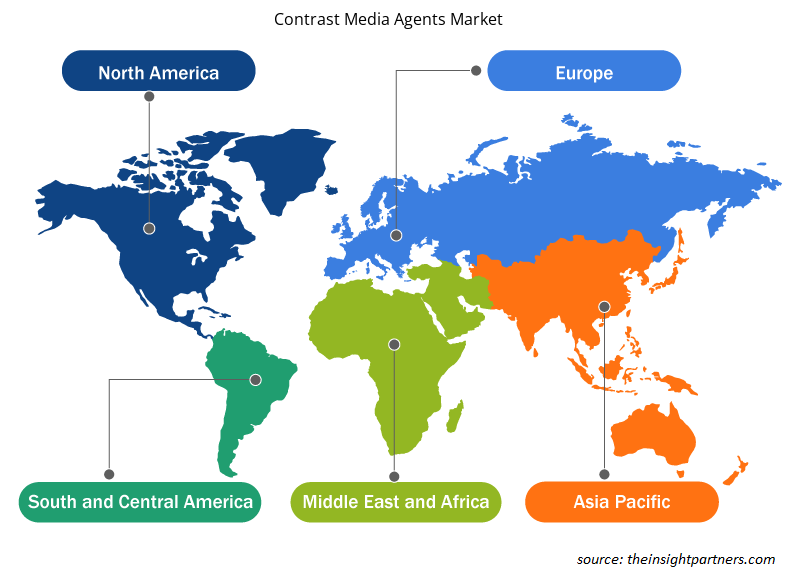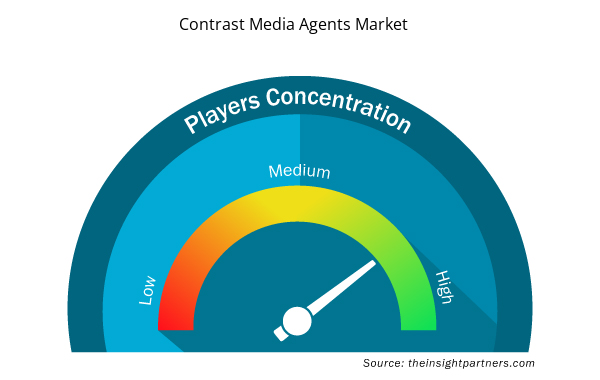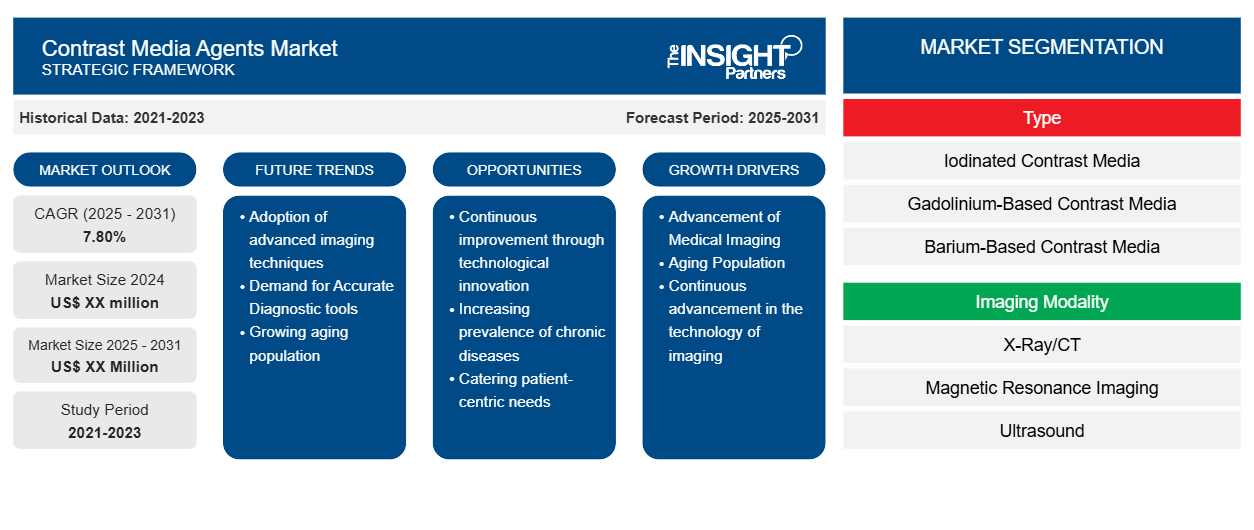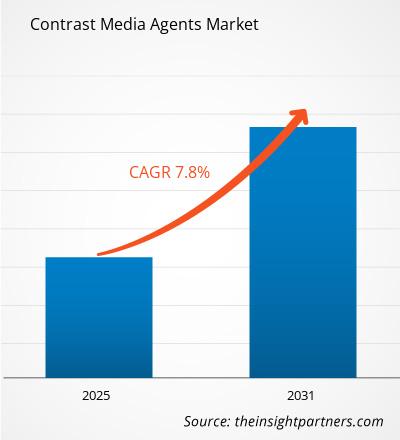Le marché des agents de contraste devrait enregistrer un TCAC de 7,80 % de 2024 à 2031, avec une taille de marché passant de XX millions USD en 2024 à XX millions USD d'ici 2031.
Le rapport classe le marché des agents de contraste en type, modalité d’imagerie, indication et par voie d’administration. Le rapport examine le marché, par type, pour différents types d’agents de contraste, tels que les agents iodés, à base de baryum et à base de gadolinium, ainsi qu’une étude sur les différentes voies d’administration, telles que l’intraveineuse, l’orale et le rectal. Une analyse des utilisateurs finaux est effectuée pour les hôpitaux, les centres d’imagerie diagnostique et les instituts de recherche, présentant des informations sur les facteurs de demande dans différents contextes de soins de santé.
Objectif du rapport
Le rapport sur le marché des agents de contraste de The Insight Partners vise à décrire le paysage actuel et la croissance future, les principaux facteurs moteurs, les défis et les opportunités. Cela fournira des informations à diverses parties prenantes commerciales, telles que :
- Fournisseurs/fabricants de technologie : pour comprendre l’évolution de la dynamique du marché et connaître les opportunités de croissance potentielles, leur permettant de prendre des décisions stratégiques éclairées.
- Investisseurs : Effectuer une analyse complète des tendances concernant le taux de croissance du marché, les projections financières du marché et les opportunités qui existent tout au long de la chaîne de valeur.
- Organismes de réglementation : Réglementer les politiques et surveiller les activités du marché dans le but de minimiser les abus, de préserver la confiance des investisseurs et de maintenir l’intégrité et la stabilité du marché.
Segmentation du marché des agents de contraste
Taper
- Produits de contraste iodés
- Produits de contraste à base de gadolinium
- Produits de contraste à base de baryum
- Produit de contraste à microbulles
Modalité d'imagerie
- Radiographie/TDM
- Imagerie par résonance magnétique
- Ultrason
Indication
- Troubles cardiovasculaires
- Cancer
- Troubles gastro-intestinaux
- Troubles musculo-squelettiques
- Troubles neurologiques
- Troubles néphrologiques
Voie d'administration
- Intravasculaire
- Oral
- Rectal
Personnalisez ce rapport en fonction de vos besoins
Vous bénéficierez d'une personnalisation gratuite de n'importe quel rapport, y compris de certaines parties de ce rapport, d'une analyse au niveau des pays, d'un pack de données Excel, ainsi que de superbes offres et réductions pour les start-ups et les universités.
- Obtenez les principales tendances clés du marché de ce rapport.Cet échantillon GRATUIT comprendra une analyse de données, allant des tendances du marché aux estimations et prévisions.
Facteurs de croissance du marché des agents de contraste
- Progrès de l'imagerie médicale : Le marché des agents de contraste se caractérise par une forte croissance en raison d'un ensemble de facteurs d'influence qui reflètent les progrès de l'imagerie médicale et la demande croissante de diagnostic. Selon l'OMS, les maladies cardiovasculaires sont la principale cause de décès dans le monde et font chaque année environ 17,9 millions de morts. Ce fait horrible entraîne une demande croissante de services de diagnostic utilisant des agents de contraste pour des techniques d'imagerie telles que l'IRM, les tomodensitogrammes et les rayons X.
- Vieillissement de la population : Le vieillissement de la population est un autre facteur important. Avec une espérance de vie plus longue, les personnes âgées sont plus susceptibles de développer des problèmes de santé qui nécessitent le recours à l’imagerie pour un diagnostic et un traitement appropriés. Selon les Nations Unies, d’ici 2050, il y aura environ 1,5 milliard de personnes âgées de 65 ans et plus, soit près du double de la population de 2020. Cela crée une spirale ascendante de la demande en imagerie diagnostique et, plus important encore, un besoin croissant d’agents de contraste de haute qualité pour aider à créer des images plus claires et plus précises.
- Les progrès continus dans la technologie de l'imagerie : la modalité propulse également la croissance du marché des agents de contraste. Des innovations telles que l'imagerie 3D, l'imagerie en temps réel et les techniques de résolution améliorées ont amélioré l'efficacité et l'efficience des procédures de diagnostic. Par exemple, les développements de l'IRM ont considérablement augmenté le contraste des tissus mous, et par conséquent la qualité de l'agent de contraste doit être aussi fine que possible afin de fournir des images nettes et précises. Ainsi, avec l'adoption de ces modalités d'imagerie avancées, la demande d'agents de contraste spéciaux devrait augmenter en conséquence.
Tendances futures du marché des agents de contraste
- Adoption de techniques d'imagerie avancées : le développement de modalités telles que l'IRM, la tomodensitométrie et l'échographie a accru le besoin d'agents de haute qualité qui fournissent des images plus nettes avec une meilleure définition et une meilleure résolution. L'amélioration continue grâce à l'innovation technologique en matière de clarté et de détails des images signifie qu'il y aura un besoin croissant de produits de contraste efficaces pour améliorer la précision du diagnostic chez les professionnels de la santé. Par exemple, des microbulles ultra-petites sont développées pour augmenter l'imagerie par ultrasons afin de visualiser clairement le flux sanguin et la perfusion tissulaire lors du diagnostic de diverses affections.
- Demande d'outils de diagnostic précis : Une autre tendance importante du marché des agents de contraste est la prévalence croissante des maladies chroniques, qui stimule la demande d'outils de diagnostic précis. L'Organisation mondiale de la santé considère les maladies non transmissibles, telles que les maladies cardiovasculaires et les cancers, comme les principales causes de mortalité dans le monde. L'incidence croissante met un nouvel accent sur la nécessité de solutions disponibles en imagerie, car un diagnostic précoce est souvent crucial pour les résultats possibles du traitement. La plupart des pays ont adopté des systèmes de santé axés sur le diagnostic et les soins précoces ; ainsi, leur dépendance aux agents de contraste dans ces diagnostics a également augmenté de manière significative.
- Vieillissement de la population : Le vieillissement de la population est un facteur déterminant des tendances du marché. En effet, les estimations faisant état d’environ 1,5 milliard de personnes âgées de 65 ans et plus d’ici 2050 dans le monde, la demande de services d’imagerie médicale devrait probablement augmenter en conséquence. Les personnes âgées sont plus sujettes à différents problèmes de santé, dont la plupart nécessitent des services d’imagerie pour le diagnostic et la prise en charge appropriée. Le principal changement démographique nécessite en effet une approche impliquant l’utilisation d’agents de contraste conçus en tenant compte des besoins et des exigences des patients âgés ; cela exige une innovation dans la conception de la formulation pour minimiser les risques et augmenter la sécurité.
- Un environnement réglementaire en constante évolution : L'environnement réglementaire en constante évolution a mis davantage l'accent sur les considérations de sécurité et d'efficacité. Plusieurs organismes de réglementation encouragent le développement d'agents de contraste qui seraient plus sûrs et entraîneraient moins d'événements indésirables, en particulier chez les patients souffrant de pathologies prédominantes telles qu'une insuffisance rénale ou des troubles allergiques. Par exemple, on assiste au développement d'agents de contraste non iodés pour les patients susceptibles d'être sensibles à l'iode. Cette tendance garantit donc non seulement la sécurité, mais augmente également la population pouvant subir une imagerie avec contraste.
- Médecines personnalisées : il s’agit d’une tendance croissante vers la médecine personnalisée, où les traitements et les stratégies diagnostiques sont adaptés au profil spécifique du patient. Cette tendance s’applique également aux produits de contraste, car les agents ciblés actuellement en recherche auront une imagerie spécifique dans des conditions ou des populations sélectionnées. De telles avancées offriraient une meilleure précision diagnostique et une meilleure efficacité thérapeutique.
Opportunités de marché pour les agents de contraste
- Amélioration continue grâce à l'innovation technologique : les progrès technologiques en matière de clarté et de détails des images signifient qu'il y aura un besoin croissant de produits de contraste efficaces pour améliorer la précision du diagnostic chez les professionnels de la santé. Par exemple, des microbulles ultra-petites sont développées pour améliorer l'imagerie par ultrasons afin de visualiser clairement le flux sanguin et la perfusion tissulaire lors du diagnostic de diverses affections.
- La prévalence croissante des maladies chroniques entraîne une demande accrue d’outils de diagnostic précis. L’Organisation mondiale de la santé considère les maladies non transmissibles, telles que les maladies cardiovasculaires et les cancers, comme les principales causes de mortalité dans le monde. L’incidence croissante de ces maladies met l’accent sur la nécessité de disposer de solutions d’imagerie disponibles, car un diagnostic précoce est souvent crucial pour les résultats possibles du traitement. La plupart des pays ont adopté des systèmes de santé axés sur le diagnostic et les soins précoces ; leur dépendance aux agents de contraste dans ces diagnostics a donc également augmenté de manière significative.
- Répondre aux besoins centrés sur le patient : De plus, on observe une tendance croissante vers la médecine personnalisée, où les traitements et les stratégies diagnostiques sont adaptés au profil spécifique du patient. Cette tendance est également valable pour les produits de contraste, car les agents ciblés actuellement en cours de recherche auront une imagerie spécifique dans des conditions ou des populations sélectionnées. De telles avancées offriraient une meilleure précision diagnostique et une meilleure efficacité thérapeutique.
Aperçu régional du marché des agents de contraste
Les tendances et facteurs régionaux influençant le marché des agents de contraste tout au long de la période de prévision ont été expliqués en détail par les analystes d’Insight Partners. Cette section traite également des segments et de la géographie du marché des agents de contraste en Amérique du Nord, en Europe, en Asie-Pacifique, au Moyen-Orient et en Afrique, ainsi qu’en Amérique du Sud et en Amérique centrale.

- Obtenez les données régionales spécifiques au marché des agents de contraste
Portée du rapport sur le marché des agents de contraste
| Attribut de rapport | Détails |
|---|---|
| Taille du marché en 2024 | XX millions de dollars américains |
| Taille du marché d'ici 2031 | XX millions de dollars américains |
| Taux de croissance annuel composé mondial (2024-2031) | 7,80% |
| Données historiques | 2021-2023 |
| Période de prévision | 2025-2031 |
| Segments couverts | Par type
|
| Régions et pays couverts | Amérique du Nord
|
| Leaders du marché et profils d'entreprises clés |
|
Densité des acteurs du marché des agents de contraste : comprendre son impact sur la dynamique commerciale
Le marché des agents de contraste connaît une croissance rapide, tirée par la demande croissante des utilisateurs finaux en raison de facteurs tels que l'évolution des préférences des consommateurs, les avancées technologiques et une plus grande sensibilisation aux avantages du produit. À mesure que la demande augmente, les entreprises élargissent leurs offres, innovent pour répondre aux besoins des consommateurs et capitalisent sur les tendances émergentes, ce qui alimente davantage la croissance du marché.
La densité des acteurs du marché fait référence à la répartition des entreprises ou des sociétés opérant sur un marché ou un secteur particulier. Elle indique le nombre de concurrents (acteurs du marché) présents sur un marché donné par rapport à sa taille ou à sa valeur marchande totale.
Les principales entreprises opérant sur le marché des agents de contraste sont :
- Général Électrique
- Bayer AG
- Braque
- GUERBET
Avis de non-responsabilité : les sociétés répertoriées ci-dessus ne sont pas classées dans un ordre particulier.

- Obtenez un aperçu des principaux acteurs du marché des agents de contraste
Principaux arguments de vente
- Couverture complète : Le rapport couvre de manière exhaustive l’analyse des produits, des services, des types et des utilisateurs finaux du marché des agents de contraste, offrant un paysage holistique.
- Analyse d’experts : Le rapport est compilé sur la base d’une compréhension approfondie des experts et analystes du secteur.
- Informations à jour : Le rapport garantit la pertinence commerciale en raison de sa couverture des informations récentes et des tendances des données.
- Options de personnalisation : ce rapport peut être personnalisé pour répondre aux exigences spécifiques du client et s'adapter parfaitement aux stratégies commerciales.
Le rapport de recherche sur le marché des agents de contraste peut donc aider à ouvrir la voie au décodage et à la compréhension du scénario de l’industrie et des perspectives de croissance. Bien qu’il puisse y avoir quelques préoccupations valables, les avantages globaux de ce rapport ont tendance à l’emporter sur les inconvénients.
- Analyse historique (2 ans), année de base, prévision (7 ans) avec TCAC
- Analyse PEST et SWO
- Taille du marché Valeur / Volume - Mondial, Régional, Pays
- Industrie et paysage concurrentiel
- Ensemble de données Excel



Report Coverage
Revenue forecast, Company Analysis, Industry landscape, Growth factors, and Trends

Segment Covered
This text is related
to segments covered.

Regional Scope
North America, Europe, Asia Pacific, Middle East & Africa, South & Central America

Country Scope
This text is related
to country scope.
Questions fréquemment posées
The report can be delivered in PDF/PPT format; we can also share excel dataset based on the request.
Some of the customization options available based on request are additional 3-5 company profiles and country-specific analysis of 3-5 countries of your choice. Customizations are to be requested/discussed before making final order confirmation, as our team would review the same and check the feasibility.
General Electric, Bayer AG, Bracco, GUERBET, Lantheus Medical Imaging Inc, nanoPET Pharma GmbH, Unijules Life Sciences Ltd, Magnus Health Management Pvt Ltd are key players in this market
The market is expected to register a CAGR of 7.8% during 2023-2031
Major driving factors for the Contrast Media Agents Market include the prevalence of chronic diseases, aging of the population, improvement in technology related to imaging modalities, rise in the number of diagnostic procedures, innovative regulations, a focus on personalized medicine, and better awareness of early diagnosis of diseases. All these factors combined present a very strong environment where the growth and evolution of the contrast media agents market can thrive.
The trend shaping the radiological contrast media market includes the adoption of advanced imaging techniques, an increase in the prevalence of chronic diseases, and the older population, changing regulatory standards, a shift toward personalized medicine, and integration of digital technologies. Such factors, together, keep driving innovation and widening the scope of use of the contrast media agents and set this market on track for significant growth over the next few years.
Trends and growth analysis reports related to Life Sciences : READ MORE..
The List of Companies
1. General Electric
2. Bayer AG
3. Bracco
4. GUERBET
5. Lantheus Medical Imaging, Inc.
6. nanoPET Pharma GmbH
7. Unijules Life Sciences Ltd.
8. Magnus Health Management Pvt Ltd.
9. J.B.Chemicals and Pharmaceuticals Ltd.
10. Jodas Expoim
The Insight Partners performs research in 4 major stages: Data Collection & Secondary Research, Primary Research, Data Analysis and Data Triangulation & Final Review.
- Data Collection and Secondary Research:
As a market research and consulting firm operating from a decade, we have published and advised several client across the globe. First step for any study will start with an assessment of currently available data and insights from existing reports. Further, historical and current market information is collected from Investor Presentations, Annual Reports, SEC Filings, etc., and other information related to company’s performance and market positioning are gathered from Paid Databases (Factiva, Hoovers, and Reuters) and various other publications available in public domain.
Several associations trade associates, technical forums, institutes, societies and organization are accessed to gain technical as well as market related insights through their publications such as research papers, blogs and press releases related to the studies are referred to get cues about the market. Further, white papers, journals, magazines, and other news articles published in last 3 years are scrutinized and analyzed to understand the current market trends.
- Primary Research:
The primarily interview analysis comprise of data obtained from industry participants interview and answers to survey questions gathered by in-house primary team.
For primary research, interviews are conducted with industry experts/CEOs/Marketing Managers/VPs/Subject Matter Experts from both demand and supply side to get a 360-degree view of the market. The primary team conducts several interviews based on the complexity of the markets to understand the various market trends and dynamics which makes research more credible and precise.
A typical research interview fulfils the following functions:
- Provides first-hand information on the market size, market trends, growth trends, competitive landscape, and outlook
- Validates and strengthens in-house secondary research findings
- Develops the analysis team’s expertise and market understanding
Primary research involves email interactions and telephone interviews for each market, category, segment, and sub-segment across geographies. The participants who typically take part in such a process include, but are not limited to:
- Industry participants: VPs, business development managers, market intelligence managers and national sales managers
- Outside experts: Valuation experts, research analysts and key opinion leaders specializing in the electronics and semiconductor industry.
Below is the breakup of our primary respondents by company, designation, and region:

Once we receive the confirmation from primary research sources or primary respondents, we finalize the base year market estimation and forecast the data as per the macroeconomic and microeconomic factors assessed during data collection.
- Data Analysis:
Once data is validated through both secondary as well as primary respondents, we finalize the market estimations by hypothesis formulation and factor analysis at regional and country level.
- Macro-Economic Factor Analysis:
We analyse macroeconomic indicators such the gross domestic product (GDP), increase in the demand for goods and services across industries, technological advancement, regional economic growth, governmental policies, the influence of COVID-19, PEST analysis, and other aspects. This analysis aids in setting benchmarks for various nations/regions and approximating market splits. Additionally, the general trend of the aforementioned components aid in determining the market's development possibilities.
- Country Level Data:
Various factors that are especially aligned to the country are taken into account to determine the market size for a certain area and country, including the presence of vendors, such as headquarters and offices, the country's GDP, demand patterns, and industry growth. To comprehend the market dynamics for the nation, a number of growth variables, inhibitors, application areas, and current market trends are researched. The aforementioned elements aid in determining the country's overall market's growth potential.
- Company Profile:
The “Table of Contents” is formulated by listing and analyzing more than 25 - 30 companies operating in the market ecosystem across geographies. However, we profile only 10 companies as a standard practice in our syndicate reports. These 10 companies comprise leading, emerging, and regional players. Nonetheless, our analysis is not restricted to the 10 listed companies, we also analyze other companies present in the market to develop a holistic view and understand the prevailing trends. The “Company Profiles” section in the report covers key facts, business description, products & services, financial information, SWOT analysis, and key developments. The financial information presented is extracted from the annual reports and official documents of the publicly listed companies. Upon collecting the information for the sections of respective companies, we verify them via various primary sources and then compile the data in respective company profiles. The company level information helps us in deriving the base number as well as in forecasting the market size.
- Developing Base Number:
Aggregation of sales statistics (2020-2022) and macro-economic factor, and other secondary and primary research insights are utilized to arrive at base number and related market shares for 2022. The data gaps are identified in this step and relevant market data is analyzed, collected from paid primary interviews or databases. On finalizing the base year market size, forecasts are developed on the basis of macro-economic, industry and market growth factors and company level analysis.
- Data Triangulation and Final Review:
The market findings and base year market size calculations are validated from supply as well as demand side. Demand side validations are based on macro-economic factor analysis and benchmarks for respective regions and countries. In case of supply side validations, revenues of major companies are estimated (in case not available) based on industry benchmark, approximate number of employees, product portfolio, and primary interviews revenues are gathered. Further revenue from target product/service segment is assessed to avoid overshooting of market statistics. In case of heavy deviations between supply and demand side values, all thes steps are repeated to achieve synchronization.
We follow an iterative model, wherein we share our research findings with Subject Matter Experts (SME’s) and Key Opinion Leaders (KOLs) until consensus view of the market is not formulated – this model negates any drastic deviation in the opinions of experts. Only validated and universally acceptable research findings are quoted in our reports.
We have important check points that we use to validate our research findings – which we call – data triangulation, where we validate the information, we generate from secondary sources with primary interviews and then we re-validate with our internal data bases and Subject matter experts. This comprehensive model enables us to deliver high quality, reliable data in shortest possible time.


 Obtenez un échantillon gratuit pour ce rapport
Obtenez un échantillon gratuit pour ce rapport